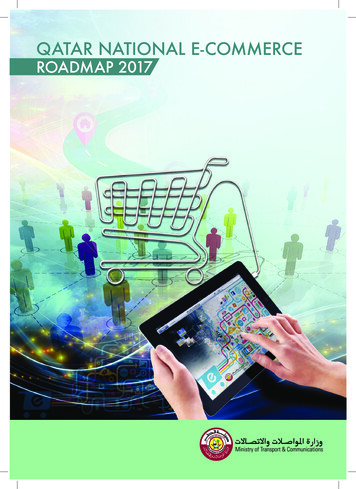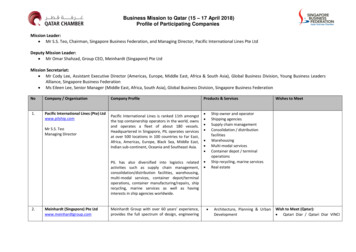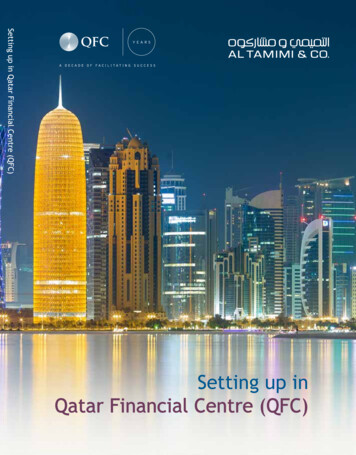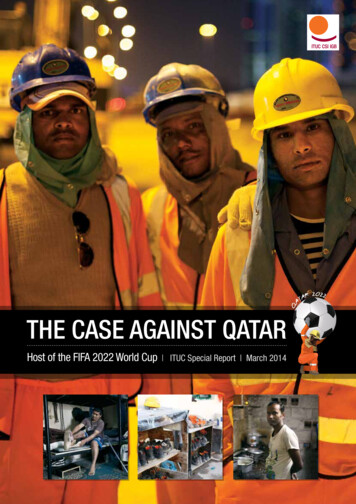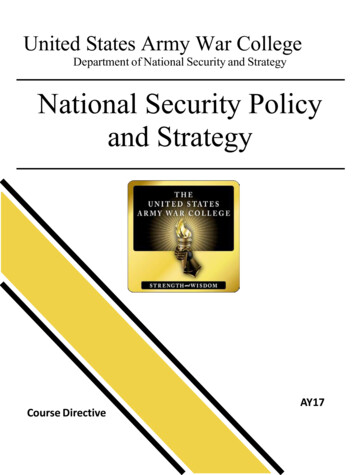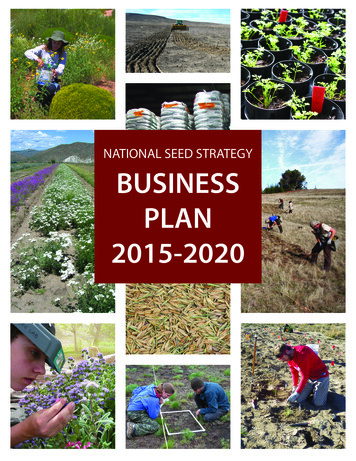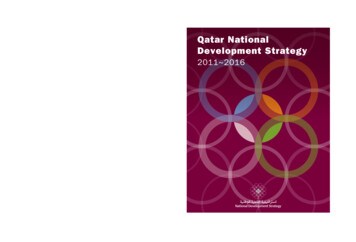
Transcription
2011 2016Qatar National Development Strategy 2011–2016Qatar NationalDevelopment StrategyTowards Qatar National Vision 2030
Qatar NationalDevelopment Strategy2011 2016Towards Qatar National Vision 2030
Copyright 2011 by the Qatar General Secretariat for Development Planning.First published March 2011.Reprinted June 2011.Qatar General Secretariat for Development PlanningDoha TowersP.O. Box 1855Doha, Qatarwww.gsdp.gov.qaDesign and editing by Communications Development Incorporated, Washington, DC.Printed by Gulf Publishing and Printing Company, Doha.The content of this publication may be freely reproduced for noncommercial purposes with attribution tothe copyright holder.
ForewordUnder the guidance of His Highness Sheikh Hamad Bin Khalifa Al-Thani, our beloved Emir, thepioneer of our advancement and the leader of our march forward, the first National DevelopmentStrategy for the State of Qatar 2011–2016 was prepared to set a path towards achieving the goals ofQatar National Vision 2030.The National Strategy deepens our commitment to increasing the well-being of all Qatari citizensand lays out a carefully designed programme for how to continue providing the best education andhealthcare as well as social protection and employment opportunities in a prosperous, stable and securesociety that nurtures its members and preserves and protects family cohesion.A product of consultations with all segments of Qatari society, including the private sector and civilsociety, the Strategy takes into account Qatar’s cultural and religious values, as well as the needs offuture generations, covering all aspects of social, economic and environmental activity.Qatar’s tremendous progress is clear in all fields. However, the stresses that accompany rapid progressare also visible. Our mission—balanced and sustainable growth—requires responsible use of resourcesand continuous modernization and development of public institutions to ensure good programmemanagement and high-quality public services.This Strategy also highlights our competitive position in the international economy and reminds us ofthe effective role we must play at both the regional and international levels.I would like to thank all those who contributed—in particular, the National Steering Committee, theExecutive Groups, Task Teams and technical support groups. I would also like to commend the GeneralSecretariat for Development Planning and its Secretary General for their role in coordinating thepreparation of the Strategy.Everyone in Qatar, including the private sector and civil society, must fully commit to implementingthe Strategy’s framework and achieving its development objectives. Doing so will bring prosperity andbenefits for us today as well as for Qatar’s future generations.May Allah guide our steps.Tamim Bin Hamad Al-ThaniHeir ApparentHead, Supreme Oversight Committee for implementing Qatar National Vision 2030March 2011 iii
ContentsForeword iiiEnhancing market efficiency Regulation and efficiency Building a diversified economy Supreme Oversight Committee for Implementing QatarNational Vision 2030 xMembers of the National Development Strategy NationalSteering Committee xMembers of the Executive Groups xiTask team chairs xiiGeneral Secretariat for Development Planningmanagement support xiiNational Development Strategy 2011–2016 Sector Reports xiiiExecutive summary Chapter 4 Promoting human development 103Nurturing a healthy population Challenges for healthcare Realizing Qatar National Vision 2030 for ahealthy population A comprehensive world-class healthcare system An integrated system of healthcare A focus on preventive healthcare A skilled national healthcare workforce A national health policy Effective and affordable services through partnershipsin bearing healthcare costs High-quality research directed at improving theeffectiveness and quality of healthcare Prerequisites for implementation Fostering cross-sectoral links Building knowledge and skills Desired qualities of Qatar’s education and training system Growing importance of private and independent schoolsand rising enrolment of children of expatriates Realizing Qatar National Vision 2030 for educationand training Addressing core education and training issues Improving K–12 general education Improving higher education Enhancing scientific research Fostering cross-sectoral links Fostering a capable and motivated workforce Challenges for the labour market Realizing Qatar National Vision 2030 for a capableand motivated workforce Expanding high-quality training opportunities for Qataris Incentivizing Qatari private sector employment Boosting labour force productivity Attracting and retaining high-quality expatriate talent Nurturing and managing human resources Improving labour market flexibility 1Part 1 Agenda and resourcesChapter 1 Building Qatar’s firstdevelopment strategy 33From vision to strategy: tackling the big challenges 34Preparing the National Development Strategy 2011–2016 35National Development Strategy 2011–2016 programmesand projects 38Growth with balance 39Four interrelated pillars of development 39A programme for the entire society 40Building on momentum 41Chapter 2 Achievements and economicoutlook 2011–2016 43A solid foundation for the future Outlook for 2011–2016 Supporting the National Development Strategy 2011–2016 445161Part 2 The four development pillarsChapter 3 Sustaining economic prosperity 67Expanding the productive base Enhancing economic stability Enhancing technical and economic efficiency 697480889093 8132137143144146147148149151152153154155v
Building the capacity of key labour market stakeholders Strengthening evidence-based policy-making Enhancing employment and career counselling services Implementation challenges Fostering cross-sectoral links Chapter 5 An integrated approach tosound social development 155156157158160161Family cohesion: the core of Qatari society 165Reinforcing family cohesion 166Strengthening parental roles 168Reducing domestic violence 169Supporting families with special circumstances 171Reducing economic and social vulnerability andimproving financial management 171Adopting a holistic approach to child well-being 172Improving work-life balance for women 174Increasing women’s empowerment 175Fostering cross-sectoral links 177Social safeguards for a caring society 179Improving and strengthening the social protection system 179Making the workforce and society more inclusive 183Extending social responsibility to the business community 185Fostering cross-sectoral links 186Public protection for a stable society 188Improving crime management 188Improving road traffic safety 190Strengthening occupational health and safety 192Enhancing building safety standards 193Coordinating national emergency preparedness 194Fostering cross-sectoral links 194Sports as inspiration for an active and healthy society 196Promoting healthy and active living through sports 197Equipping the country with accessible sports facilities 199Propelling the country to sporting excellence 200Fostering cross-sectoral links 202Cultural growth for a creative and exceptional society 204Increasing demand and support for diverse culturalactivities 205Improving management of heritage resources 206Investing in young people 207Developing high-quality artistic talent 208Providing better information for cultural advocacy 209Strengthening Qatar’s cultural diplomacy 209Fostering cross-sectoral links 210Moving social development forward vi 212Qatar National Development Strategy 2011–2016Chapter 6 Sustaining the environmentfor future generations 213Managing resources and protecting opportunity forfuture generations 214Realizing Qatar National Vision 2030 for sustainability 216Cleaner water and sustainable use 217Cleaner air and effective climate change responses 221Reduced waste, more recycling and more efficient use 224Nature and natural heritage conserved, protected andsustainably managed 226More sustainable urbanization and a healthier living environment 228An increasingly environmentally aware population 229Improved governance and regional and international cooperation 230Deepening the national commitment—creating theknowledge base 232Fostering cross-sectoral links 236Part 3 Institutions and implementationChapter 7 Developing modern publicsector institutions 241The drivers and levers of institutional development andmodernization 243Mapping Qatar’s institutional development andmodernization journey 245Possible pathways to public sector institutional development 249Programmes to develop and modernize public sector institutions 250Strategic policy and planning 252Budget and financial management 253Organizational alignment 254Human resources development 256Enabled institutional processes 257Performance management 259Project priorities and fostering cross-sectoral links 260Chapter 8 Moving from strategyto implementation 263Embracing an expanded orientation and new ways of working 264Strategic thrusts 264The building blocks of implementation 265The human resources constraint 267Budgetary resources for the strategy 267Bridging the information and knowledge gap 269Implementation through participation, communicationand advocacy 269Monitoring and evaluation 270
Boxes2.13.13.23.36.1Glimpsing the economy’s future 52Discounting the future—calculating limits on consumption 70Economic Development Board of Singapore 74Calibrating government involvement in industry 97Major environmental interventions carry knowledgedemands 2337.1 Best practices, by levers of public sector performance 2468.1 The value of quick wins 265Figures1.1 The National Development Strategy 2011–2016 wasdeveloped through a combination of top‑down andbottom-up approaches 361.2 Preparation of the National Development Strategy2011–2016 was broadly participatory and inclusive 371.3 The National Development Strategy 2011–2016organizational structure 382.1 Qatar has grown faster than any other economy, andits per capita GDP is now among the highest in the world 452.2 Qatar is a global leader in liquefied natural gas production 462.3 Qatar’s spending on infrastructure over 2005–2009has outpaced that of other countries experiencingaccelerating growth 472.4 Government spending is strongly correlated with oilprices and government revenue 482.5 Beyond 2011 real GDP growth is likely to shift down 512.6 With hydrocarbon growth decelerating, robust expansionelsewhere in the economy will help keep overall GDPgrowth buoyant 542.7 By 2016 the service sector may account for nearly40% of total output, up from 36% in 2009 542.8 Qatar’s population is expected to grow steadily, at anannual average of about 2.1% during 2011–2016 552.9 During 2011–2016 total gross domestic investmentmight approach QR 820 billion 562.10 The ratios of gross national saving to total GDP andgovernment saving to GDP are expected to decline butremain substantial 572.11 The overall government fiscal position is expected toremain healthy, with a surplus of 5.7% of GDP by 2016 572.12 Oil prices are projected to rise, gas prices to remainrange bound 582.13 The current account surplus should remain sizeable,peaking at 24% of GDP in 2011, declining to 15% by 2016 582.14 An assumed 30% fall in the prices of Qatar’s liquefiednatural gas basket reduces nominal GDP 603.1 Sustainability and the economic framework 693.2 The government plans more than 65 billion ininfrastructure spending through 2016 723.3 Inflation accelerated sharply from 2005, hitting a highof about 15% in the first quarter of 2008 753.4 For a hydrocarbon-exporting economy such as Qatar,price shifts hit the fiscal revenue stream directly, creatingripple effects throughout society 763.5 The volatility of oil prices makes it difficult for policymakers to judge the most constructive fiscal stance 763.6 Elements of efficiency interact and link to sectors andfocus areas 803.7 A snapshot of Qatar’s infrastructure in capacity, qualityand cost 823.8 Qatar relies on water from desalination, which is subjectto inefficiencies that may threaten water security orrequire large investments to ease shortages 833.9 Operators should be commercially motivated, disciplined bymarkets as well as accountable to regulators, and protectedfrom political interference, but Qatar lacks these separations 913.10 Little diversification of output has occurred over thelast decade 943.11 Only 41% of new products exported from Qatar surviveuntil the next year 953.12 Labour productivity is falling across most sectors 953.13 Qatar is vulnerable to underlying pressures for realexchange rate appreciation, making its exports morecostly and less competitive 963.14 Economic prosperity is both a goal and an enabler toachieve the aspirations of Qatar National Vision 2030 1014.1 Links between the National Development Strategy2011–2016 and the Supreme Council of Health 1074.2 Current and future models of healthcare 1104.3 Healthcare spending in Qatar has risen nearly fivefoldsince 2001 1174.4 A healthy population is both a goal and an enabler toachieve the aspirations of Qatar National Vision 2030 1214.5 With the growth in the number of school-going childrenin Qatar, demand for international and communityschools is rising 1254.6 Government spending on education and training ishigh in Qatar compared with benchmark countries 1264.7 The share of Qataris in international schools at alllevels grew markedly between 2003/2004 and2008/2009 1274.8 Most students in Qatar have ready access tocomputers at school 130Contents vii
4.9 The number of Qatari and non-Qatari kindergartenstudents is increasing rapidly, and most attend privateschools 1334.10 Participation in primary schooling is high in Qatarcompared with regional benchmarks, but there isscope for higher participation in secondary schooling 1334.11 Average annual expenditure on higher educationper student is above the Organisation for EconomicCo‑operation and Development average 1384.12 Gross enrolment ratios for tertiary education arelow for Qataris, especially for men, compared withbenchmark countries, 2006–2008 1394.13 Qatari students need more technical education andvocational training pathways to employment 1424.14 Qatar needs to increase the proportion of science andmath graduates 1434.15 Education and training are both a goal and anenabler to achieve the aspirations of Qatar NationalVision 2030 1454.16 Qataris as a share of the labour force, actual andprojected under two scenarios, 2001–2016 1474.17 Labour force participation rates of Qatari womenhave risen rapidly but remain below those in selecteddeveloped countries 1524.18 Productivity in selected sectors in Qatar compareswell with that in benchmark countries, but not inconstruction and services, 2009 1534.19 Qatar needs to shift its employment distributiontowards a higher share of skilled labour, 2008 1544.20 Qatari men start to retire from the labour force earlierthan men in most other countries 1564.21 Key stakeholders in Qatar’s labour market governanceand links 1574.22 A capable and motivated workforce is both a goal andan enabler to achieve the aspirations of Qatar NationalVision 2030 1595.1 Qatari households remain relatively large 1665.2 Qatari women are having fewer children than they did ageneration ago 1675.3 The divorce rate per 1,000 married Qataris rose from17.4 in 1995 to 19.2 in 2009 1675.4 Domestic violence cases are prevalent in Qatar 1695.5 More financial responsibility and less indebtednessare needed 1725.6 Qatar will adopt a policy-making approach in the bestinterest of children’s well-being 1735.7 The labour force participation rate of Qatari women174rose sharply from 2001 to 2009 viii Qatar National Development Strategy 2011–20165.8 Qatari women with a university education areemployed mainly as professionals 1765.9 Family cohesion and women’s empowerment is botha goal and an enabler to achieve the aspirations ofQatar National Vision 2030 1785.10 A noncontributory cash transfer system targetsvulnerable groups 1805.11 Benefits must be regularly reviewed against inflationto maintain annual purchasing power 1815.12 A six-step model to guide the development of Qatar’scorporate responsibility policy framework 1865.13 Social protection is both a goal and an enabler toachieve the aspirations of Qatar National Vision 2030 1875.14 Road accidents involving at least one vehicle andresulting in damage and injury have been increasingsince 2003 1915.15 Fire-related accidents peaked in 2008 during theconstruction boom 1935.16 Public safety and security are both a goal and anenabler to achieve the aspirations of Qatar NationalVision 2030 1955.17 Lifestyle change through sports education andawareness is key for a healthier population 1975.18 Social and community influences limit Qatariwomen’s participation in sports 1985.19 Qatar is the best performer among Gulf CooperationCouncil countries in the Asian Games 2015.20 Sports is both a goal and an enabler to achieve theaspirations of Qatar National Vision 2030 2035.21 There are about 200 archaeological sites across Qatarwith more than 900 varieties of petroglyphs 2075.22 Culture is both a goal and an enabler to achieve theaspirations of Qatar National Vision 2030 2116.1 Reducing network losses and householdconsumption is key to sustainable water use 2176.2 Production of desalinated water has increasedmassively but has barely kept pace with populationgrowth 2186.3 About a third of water produced leaks into the watertable each year 2206.4 Two-thirds of Qatar’s carbon dioxide emissions stemfrom heavy industry 2236.5 Waste management hierarchy 2256.6 Qatar’s existing and prospective plans for wastemanagement 2266.7 Qatar’s biodiversity management framework iscontingent on the availability of a comprehensivebiodiversity database 228
6.8 Integrated water management across the value chain 2356.9 Environmental sustainability is both a goal and anenabler to achieve the aspirations of Qatar NationalVision 2030 2377.1 Current organization structure of Qatar’s public sectorinstitutions 2437.2 Performance management provides dynamic linksbetween drivers and levers to achieve public sectorexcellence 2447.3 Mapping Qatar’s public sector institutionalmodernization journey 2457.4 Project approach leading to prioritized and sequencedmodernization programmes 2477.5 Self-assessed public sector performance 2487.6 Constructing a public sector performance modelfor Qatar 2497.7 Overview of best practices journey to modernization 2507.8 The three phases of institutional development andmodernization: a long-term journey 2517.9 Focus areas with outcomes that will drive Qatar’spublic sector performance 2517.10 Institutional development and modernization as anenabler of all sectors 2618.1 Assessing the impacts and feasibility of programmesand projects 267Tables1Qatar’s 20 key challenges 264.1 Among employed Qataris, the highest share of unskilledare in the government sector and the highest share ofhighly skilled in the private sector, 2009 1504.2 Enrolment in technical education and vocational trainingat the secondary level as a share of total in Qatar is verylow compared with most benchmark countries, 2008 1504.3 Benchmark marginal rates of return for Qataris are highat the post-secondary level 1585.1 Qatar’s social protection system is supported bymultiple institutions and organizations 1805.2 Various civil society organizations support Qatar’s socialprotection system 1815.3 A threshold-relative national poverty line helpsidentify those in need, 2006/2007 1825.4 Evidence shows that low income is a particular problemfor larger households—relatively few income earnerssupport many dependents, 2006/2007 1825.5 Crime has been relatively stable over time, but violationsin immigration laws have increased markedly 1895.6 Qatar’s crime rates are well below global average levels 1895.7 Qatar’s road traffic injury fatality rate is markedly higherthan the average for high-income countries 1915.8 Slightly more than a third of Qatar’s traffic fatalitiesinvolve pedestrians 1915.9 Sports infrastructure owned by the Qatar OlympicCommittee and ASPIRE consists of various facilitiesaround the country 1995.10 The ratio of registered athletes to coaches hasdeclined in most sports activities 2026.1 Daily intervals reveal ozone levels that exceed safelevels in Doha 2226.2 Qatar is ranked 58th in total carbon emissions but 1stin per capita carbon emissions 2238.1 Qatar’s 20 key challenges 266Contents ix
Supreme Oversight Committee for Implementing Qatar National Vision 2030HH Sheikh Tamim Bin Hamad Al-ThaniHeir Apparent of the State of QatarChairHE Sheikh Hamad bin Jassim bin Jabor Al ThaniPrime Minister of the State of QatarDeputy ChairHE Abdullah bin Hamad Al AttiyahDeputy Prime Minister and Chairman of the Emiri DiwanMemberHE Dr. Ibrahim IbrahimSecretary General, General Secretariat for Development PlanningMemberHE Sheikh Hamad bin Jabor bin Jassim Al ThaniDirector General, General Secretariat for Development PlanningRapporteurMembers of the National Development Strategy National Steering CommitteeNameAgencyTitleHE Sheikh Abdulla bin Nasser bin Khalifa Al ThaniMinistry of InteriorMinister of State for Internal AffairsHE Yousef Hussein KamalMinistry of Economy and FinanceMinister of Economy and FinanceHE Nasser bin Abdullah Al HumaidiMinistry of LabourActing Minister of LabourHE Abdulla bin Mubark bin Abud AlmudadiMinistry of Municipality and Urban PlanningMinister of Municipality and Urban PlanningHE Dr. Mohammed bin Saleh Al SadaMinistry of Energy and IndustryMinister of Energy and IndustryHE Sheikh Nasser bin Mohammed bin Abdul AzizAl ThaniGeneral Secretariat of Council of MinistersMinister of State for Cabinet AffairsHE Sheikh Abd Al Rahman bin Khalifa bin Abd AlAziz Al ThaniMinistry of EnvironmentMinister of EnvironmentHE Nasser bin Abdullah Al HumaidiMinistry of Social AffairsMinister of Social AffairsHE Saad bin Ibrahim Al MahmoudSupreme Education CouncilMinister of Education; Secretary General,Supreme Education CouncilHE Abdullah bin Khalid Al QahtaniSupreme Council for HealthMinister of Health; Secretary General, SupremeCouncil for HealthHE Sheikh Jassim bin Abdul Aziz Al ThaniMinistry of Business and TradeMinister of Business and TradeHE Sheikh Abdullah bin Saud Al ThaniQatar Central BankGovernor, Qatar Central BankHE Dr. Ibrahim IbrahimGeneral Secretariat for Development PlanningSecretary General, General Secretariat forDevelopment PlanningHE Sheikh Hamad bin Jabor bin Jassim Al ThaniGeneral Secretariat for Development PlanningDirector General, General Secretariat forDevelopment PlanningHE Sheikha Hessa bint Hamad bin Khalifa Al Thani* Supreme Council for Family Affairs* Her Excellency Sheikha Hessa bint Hamad bin Khalifa Al Thani became a member of the NSC in December 2009.x Qatar National Development Strategy 2011–2016Chairperson, Supreme Council for Family Affairs
Members of the Executive GroupsNameAgencyTitleHE Yousef Hussein KamalMinistry of Economy and FinanceMinister of Economy and FinanceHE Sheikh Jassem bin Abdul Aziz Al ThaniMinistry of Business and TradeMinister of Business and TradeHE Sheikh Abdul Rahman bin Khalifa bin Abdul Aziz Al ThaniMinistry of Municipality and Urban PlanningMinister of Municipality and Urban PlanningHE Sheikh Abdullah bin Saud Al ThaniQatar Central BankGovernor, Qatar Central BankHE Sheikh Nasser bin Mohammed bin Abdul Aziz Al ThaniGeneral Secretariat of Council of MinistersMinister of State for Cabinet AffairsHE Dr. Mohammed bin Saleh Al SadaMinistry of Energy and IndustryMinister of Energy AffairsHE Dr. Ibrahim IbrahimGeneral Secretariat for Development Planning(GSDP)Secretary General, GSDPHE Sheikh Hamad bin Jabor bin Jassim Al ThaniGSDPDirector General, GSDPSupreme Education CouncilMinister of Education;Secretary General, Supreme Education CouncilHE Sheikh Nasser bin Mohammed bin Abdul Aziz Al ThaniGeneral Secretariat of Council of MinistersMinister of State for Cabinet AffairsHE Dr. Ibrahim IbrahimGSDPSecretary General, GSDPHE Sheikh Hamad bin Jabor bin Jassim Al ThaniGSDPDirector General, GSDPHE Dr. Mohammed Ghanem Al Ali Al MaadheedSupreme Council of HealthMember, Supreme Council of Healthand its Executive Committee;Vice Chairman, Qatar Red Crescent SocietyHE Abdullah Khalid Al-QahtaniSupreme Council of HealthMinister of Health;Secretary-General, Supreme Council of HealthHE Dr. Ibrahim IbrahimGSDPSecretary General, GSDPDr. David KerrSidra Medical and Research CentreSenior AdvisorEconomic development, sustainable economic prosperityHuman development, educated and capable populationHE Saad bin Ibrahim Al MahmoudHuman development, healthy populationHuman development, effective Qatari participation in a productive labour forceHE Nasser bin Abdullah Al HumaidiMinistry of LabourActing Minister of LabourHE Sheikh Nasser bin Mohammed bin Abdul Aziz Al ThaniGeneral Secretariat of Council of MinistersMinister of State for Cabinet AffairsHE Dr. Ibrahim IbrahimGSDPSecretary General, GSDPHE Sheikh Hamad bin Jabor bin Jassim Al ThaniGSDPDirector General, GSDPHE Sheikha Hessa bint Hamad bin Kalifa Al ThaniSupreme Council for Family AffairsChairperson, Supreme Council for Family AffairsHE Sheikh Abdulla bin Nasser bin Khalifa Al ThaniMinistry of InteriorMinister of State for Internal AffairsHE Nasser bin Abdullah Al HumaidiMinistry of Social AffairsMinister of Social AffairsHE Dr. Hamad bin Abdulaziz Al KuwariMinistry of Culture, Arts and HeritageMinister of Culture, Arts and HeritageHE Sheikh Nasser bin Mohammed bin Abdul Aziz Al ThaniGeneral Secretariat of Council of MinistersMinister of State for Cabinet AffairsHE Dr. Ibrahim IbrahimGSDPSecretary General, GSDPHE Sheikh Hamad bin Jabor bin Jassim Al ThaniGSDPDirector General, GSDPHE Sheikh Abd Al Rahman bin Khalifa bin Abd Al Aziz Al ThaniMinistry of EnvironmentMinister of EnvironmentHE Sheikh Nasser bin Mohammed bin Abdul Aziz Al ThaniMinistry of Municipality and Urban PlanningMinister of Municipality and Urban PlanningHE Dr. Ibrahim IbrahimGSDPSecretary General, GSDPHE Sheikh Hamad bin Jabor bin Jassim Al ThaniGSDPDirector General, GSDPSocial development, caring and cohesive societyEnvironmental development, environmental sustainabilityNational Development Strategy 2011–2016 team xi
Task team chairsNameAgencyTitleTask teamMr. Muftah Jassim Al MuftahMinistry of Economy and FinanceDirector, Revenues and TaxesDepartmentEconomic ManagementEng. Ibrahim Abbas HassanMinistry of Municipality andUrban PlanningFormer Director, Department ofTransportation and InfrastructurePlanning SectorEconomic InfrastructureMr. Mishaal bin Jabor Al ThaniQatar PetroleumSenior EconomistNatural Resource ManagementMr. Nasser Jarallah Al MarriMinistry of Business and TradeDirector, Business DevelopmentDepartmentEconomic Diversification and Private SectorGrowthHE Dr. Mohammed Ghanem Al AliAl MaadheedSupreme Council of HealthMember, Supreme Councilof Health and its ExecutiveCommitteeHealthcareDr. Juliet Ibrahim(Chair of the Planning Team)Supreme Council of HealthDirector, Planning andAssessment DepartmentHealthcareDr. Hamda Al SulaitiSupreme Education CouncilDirector, Evaluation InstituteEducation and TrainingMr. Hussein Yousef Al MullaMinistry of LabourUndersecretary, Ministry of LabourPopulation, Labour Force and QatariEmploymentHE Noor Al MalkiSupreme Council for Family AffairsSecretary GeneralFamily Cohesion and Women’s EmpowermentMr. Ahmed Nasr Al NasrMinistry of Social AffairsAssistant Undersecretary,Ministry of Social AffairsSocial ProtectionBrigadier Abdullah MohammedAl SuwaidiMinistry of InteriorDirector General, Civil DefenseSecurity and Public SafetyMr. Khalid Al MohannadiQatar Olympic CommitteeAssistant Secretary General forTechnical SupportSportsMr. Khalid Yousef Al MullaMinistry of Culture, Arts andHeritageDirector, Youth Affairs DeptartmentCultureMr. Yousef Ibrahim Al HamarMinistry of EnvironmentDirector of Water DepartmentEnvironmental SustainabilityDr. Saleh Al NabitGeneral Secretariat forDevelopment PlanningDirector, Department ofInstitutional DevelopmentInstitutional Development andModernizationGeneral Secretariat for Development Planning management supportxii NameDepartmentTitleHE Dr. Ibrahim IbrahimSecretary General’s OfficeSecretary GeneralHE Sheikh Hamad bin Jabor bin Jassim Al ThaniDirector General’s OfficeDirector GeneralDr. Saleh Al NabitDepartment of Institutional DevelopmentDirector, Department of Institutional Development;Director, NDS Project Management OfficeDr. Richard LeeteDepartment of Social DevelopmentDirector, Department of Social DevelopmentDr. Frank HarriganDepartment of Economic DevelopmentDirector, Department of Economic DevelopmentMr. Hamad Al AthbaJoint Services DepartmentActing Director, Department of Shared ServicesMs. Asma Nassrallah MirzaeiJoint Services DepartmentHead, Information Technology Office;Head, Communications and Public Relations UnitQatar National Development Strategy 2011–2016
The National Development Strategy 2011–2016 hasbeen distilled from 14 sector strategies and background reports prepared by the Task Teams underthe guidance of the Executive Groups and thesupervision of the National Steering Committee.The data for the figures and tables in the NationalDevelopment Strategy have been derived from thesector strategies listed here and from their relatedbackground reports.National Development Strategy 2011–2016 Sector ReportsNameAgencyCulture Sector Strategy 2011–2016Ministry of Culture, Arts and Heritage and General Secretariat forDevelopment Planning (GSDP)Economic Diversification and Private Sector DevelopmentMinistry of Business and Trade and GSDPEconomic InfrastructureMinistry of Municipality and Urban Planning and GSDPEconomic ManagementMinistry of Economy and Finance and GSDPEducation and Training Sector Strategy 2011–2016Supreme Education Council and GSDPEnvironmental Sector Strategy 2011–2016Ministry of Environment and GSDPFam
Promoting healthy and active living through sports 197 . Investing in young people 207 . 2.4 Government
